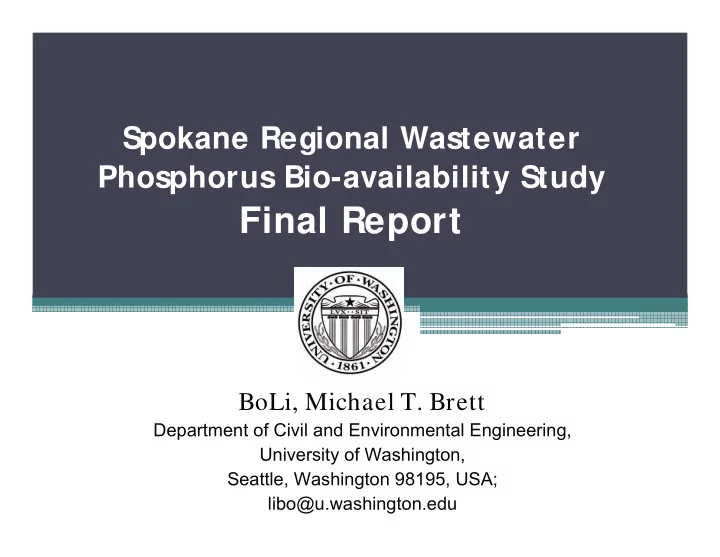

Spokane Regional Wastewater Phosphorus Bio-availability Study Final Report BoLi, Michael T. Brett Department of Civil and Environmental Engineering, University of Washington, Seattle, Washington 98195, USA; libo@u.washington.edu
Phosphorus S peciation Recalcitrant Phosphorus Inorganic P Organic P •Apatite •Polyphosphate •( Ca 3 (PO 4 ) 2 ) •Inositol hexakisphophate • Phosphate •L- α -phosphatidyl choline •AlPO 4 (PO 4-3 ) •FePO 4 •phosphoenol pyruvate •glycerophosphate
Results Granular Conventional Industrial Media Upflow sand filter Sedimentation Wastewater Filtration Spokane River Ballasted Influent Sedimentation
Intermediate Effluent Influent
S ummer S cenario INF ‐ Inffluent INT ‐ Intermediate EFFL ‐ Effluent
BAP% vs. TP in alum treatment process %BAP = -12.19*log (TP) 2 + 92.03*log(TP) + 94.17; r 2 = 0.98, n = 7, MSE = 10.3 100 80 % BAP 60 40 20 0 10000 1000 100 10 -1 Wastewater TP (µg )
Effect of Chemical Dose and Tertiary Treatment on Effluent P Species
Inland Empire Paper P concentration (µg*L -1 )
Inland Empire Paper Industrial Wastewater Expected Cell count Cell count Size (µm) Size (µm) IEP Sep. 10 Dec.3rd Chl- a (µg/ L) 1.06 1.6
BAP and TP Comparison of %
Future S tudies • Add concentrated P-free growth media to pure effluent to test for colimitation • Add concentrated P-containing growth media to pure effluent to test for toxicity • More samples (n ≈ 10) for other plants • Assess long-term BAP for selected effluent • Analyze Chl for IEP experiments
Mass Balance: Overall increase 7.8 ± 2.8 µg L -1 0.6 ± 0.2 µg L -1 Low flow period (July-Oct) 22.9 ± 6.7 µg L -1 1.7 ± 0.5 µg L -1 Either way, ∆ TP is reduced by > 90% 120 500 µg L -1 scenario 50 µg L -1 scenario 100 Frequency 80 60 40 20 0 0 5 10 15 20 ∆ TP enrichment (TP µg L -1 )
“Models will always be constrained by computational limitations, assumptions and knowledge gaps. They can best be viewed as tools to help inform decisions rather than as machines to generate truth or make decisions. Scientific advances will never make it possible to build a perfect model that accounts for every aspect of reality or to prove that a given model is correct in all aspects for a particular regulatory application. These characteristics…suggest that model evaluation be viewed as an integral and ongoing part of the life cycle of a model, from problem formulation and model conceptualization to the development and application of a computational tool.” — NRC Committee on Models in the R l t D i i P (NRC 2007)
Page 19: “ The natural complexity of environmental systems makes it difficult to mathematically describe all relevant processes, . . . The challenge facing model developers and users is determining when a model, despite its uncertainties, can be appropriately used to inform a decision .”
1. Model evaluation addresses the soundness of the underlying science, 2. the quality and quantity of available data, 3. the degree of correspondence with observed conditions, 4. Recommended evaluation process includes: a) peer review b) QA project planning, c) model corroboration d) sensitivity analyses and e) uncertainty analyses.
Conclusions 1) Our study suggests the effluents from several of the facilities discharging to Spokane River have considerably lower %BAP than conventional effluents. 2) Considering %BAP is very important because for example conventional WWTP effluents generally have much higher bioavailability than natural P sources 3) If we could start all over again, we would make several adjustments to our experimental protocol that would better account for potential confounding influences due to toxicity, nutrient colimitation, and even floc formation in our BAP bioassays 4) Field experiments examining %BAP in situ (i.e., Long Lake) would be very interesting 5) If the dischargers are able to get to lower discharge concentrations, i.e. ≈ 50 µg L -1 , and these effluents have much lower %BAP, there will be a dramatic reduction in BAP loading to the Spokane River & Long Lake 6) To adequately represent the likely impact of these much reduced discharges of bioavailable P a more carefully developed model than is currently available will be needed 7) The NRC and US EPA have recently provided very detailed guidance on how such a model should be developed 8) The definitive measure of the eutrophication potential of the new effluents will be the response of Long Lake itself during the next decade
Questions? 100 80 Percent BAP 60 40 20 0 10000 1000 100 10 Wastewater TP (µg L -1 ) Influent Intermediate Effluent
Recommend
More recommend